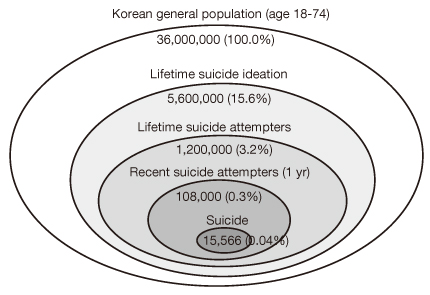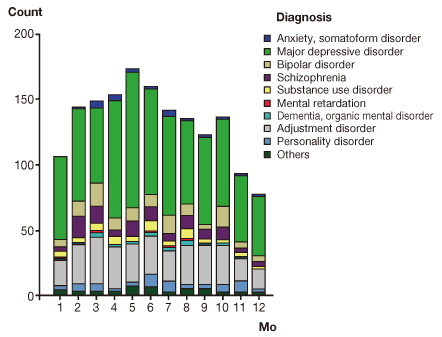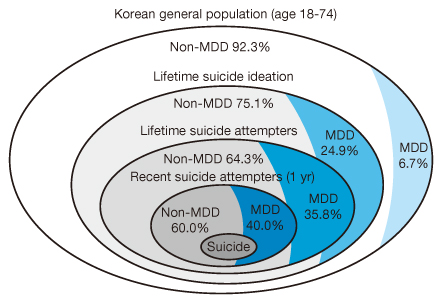J Korean Med Assoc.
2012 Apr;55(4):322-328. 10.5124/jkma.2012.55.4.322.
Epidemiologic studies on depression and suicide
- Affiliations
-
- 1Depression Center, Department of Psychiatry, Samsung Medical Center, Sungkyunkwan University School of Medicine, Seoul, Korea. jeonhj@skku.edu
- KMID: 1785365
- DOI: http://doi.org/10.5124/jkma.2012.55.4.322
Abstract
- Major depressive disorder (MDD) is defined as a state of depressed mood, loss of volition and interest, feelings of guilt and worthlessness, sleep problems, poor appetite, loss of energy, and poor concentration, which causes disability in personal and social activities. Lifetime prevalence of MDD is 6.7% (4.8% in men and 9.1% in women), and has increased by 0.2% annually for the last decade. The risk factors for suicide are MDD, severity of the MDD episode, psychotic symptoms, first episode, and being male. The suicide rate was 31.2 per 100,000 persons in the 2010 report on Death and Causes of Death in Korea, which is the seventh highest incidence in men and first in women among 105 nations from the WHO report. The lifetime rate of suicide attempts in Korea is 3.2% according to the Epidemiological Survey of Mental Disorders in Korea 2011, which is higher than the rate of China, Japan, and Western countries. It is estimated that 1,200,000 persons in Korea have attempted suicide at some point within their lifetime. Seasonal variations in suicide indicate the association between suicide and MDD. Both rates of suicide and suicide attempts are the highest in May, when a total of 52.8% of those attempting suicide were diagnosed with MDD. Forty percent of recent suicide attempts are associated with MDD, and 73.7% with MDD or alcohol use disorder in the general population. In conclusion, suicide and suicide attempts are closely associated with MDD. Suicide is a medical condition that is treatable and preventable, and suicide rates can be reduced through early diagnosis and treatment for MDD and alcohol use disorder in Korea.
MeSH Terms
Figure
Cited by 3 articles
-
Comparison of Clinical Characteristics between Single and Repeated Suicide Attempters Admitted to Emergency Room
Taehoon Koo, Kwanghun Lee, Wan Seok Seo, Jong Hun Lee, Hee-Cheol Kim, Sang Won Lee, Seunghee Won
J Korean Neuropsychiatr Assoc. 2016;55(3):224-233. doi: 10.4306/jknpa.2016.55.3.224.Prevalence of Suicidal Ideation and related Risk Factors among Korean Adults
Eunok Park, Su Jung Choi
J Korean Acad Psychiatr Ment Health Nurs. 2013;22(2):88-96. doi: 10.12934/jkpmhn.2013.22.2.88.Development of a Short Form Depression Screening Questionnaire for Korean Soldiers
Gihwan Byeon, Sun-Jin Jo, Hae-Woo Lee, Hyeon-Woo Yim, Jong-Ik Park
J Korean Med Sci. 2021;36(27):e185. doi: 10.3346/jkms.2021.36.e185.
Reference
-
1. American Psychiatric Association. Diagnostic and statistical manual of mental disorders. 1994. 4th ed. Washington, DC: American Psychiatric Association.2. Kaplan HI, Sadock BJ. Synopsis of psychiatry: behavioral sciences/clinical psychiatry. 2007. 10th ed. New York: Lippinicott Williams & Wilkins.3. Bradvik L, Mattisson C, Bogren M, Nettelbladt P. Long-term suicide risk of depression in the Lundby cohort 1947-1997: severity and gender. Acta Psychiatr Scand. 2008. 117:185–191.4. Isometsa ET, Henriksson MM, Aro HM, Heikkinen ME, Kuoppasalmi KI, Lonnqvist JK. Suicide in major depression. Am J Psychiatry. 1994. 151:530–536.5. Seoul National University College of Medicine. The epidemiological survey of mental disorders in Korea 2011. 2012. Seoul: Ministry of Health and Welfare.
Article6. Cho MJ, Kim JK, Jeon HJ, Suh T, Chung IW, Hong JP, Bae JN, Lee DW, Park JI, Cho SJ, Lee CK, Hahm BJ. Lifetime and 12-month prevalence of DSM-IV psychiatric disorders among Korean adults. J Nerv Ment Dis. 2007. 195:203–210.
Article7. Kessler RC, Berglund P, Demler O, Jin R, Koretz D, Merikangas KR, Rush AJ, Walters EE, Wang PS. National Comor-bidity Survey Replication. The epidemiology of major depressive disorder: results from the National Comorbidity Survey Replication (NCS-R). JAMA. 2003. 289:3095–3105.
Article8. Weissman MM, Bland RC, Canino GJ, Faravelli C, Greenwald S, Hwu HG, Joyce PR, Karam EG, Lee CK, Lellouch J, Lepine JP, Newman SC, Rubio-Stipec M, Wells JE, Wickramaratne PJ, Wittchen H, Yeh EK. Cross-national epidemiology of major depression and bipolar disorder. JAMA. 1996. 276:293–299.
Article9. Cho MJ, Nam JJ, Suh GH. Prevalence of symptoms of depression in a nationwide sample of Korean adults. Psychiatry Res. 1998. 81:341–352.
Article10. Shin KR, Shin C, Park SY, Yi HR. Prevalence and determining factors related to depression among adult women in Korea. J Korean Acad Nurs. 2004. 34:1388–1394.
Article11. Bromet E, Andrade LH, Hwang I, Sampson NA, Alonso J, de Girolamo G, de Graaf R, Demyttenaere K, Hu C, Iwata N, Karam AN, Kaur J, Kostyuchenko S, Lepine JP, Levinson D, Matschinger H, Mora ME, Browne MO, Posada-Villa J, Viana MC, Williams DR, Kessler RC. Cross-national epidemiology of DSM-IV major depressive episode. BMC Med. 2011. 9:90.
Article12. Chang SM, Hahm BJ, Lee JY, Shin MS, Jeon HJ, Hong JP, Lee HB, Lee DW, Cho MJ. Cross-national difference in the prevalence of depression caused by the diagnostic threshold. J Affect Disord. 2008. 159–167.
Article13. Jeon HJ. Depression and suicide. J Korean Med Assoc. 2011. 54:370–375.
Article14. Holma KM, Melartin TK, Haukka J, Holma IA, Sokero TP, Isometsa ET. Incidence and predictors of suicide attempts in DSM-IV major depressive disorder: a five-year prospective study. Am J Psychiatry. 2010. 167:801–808.
Article15. Suominen K, Haukka J, Valtonen HM, Lonnqvist J. Outcome of patients with major depressive disorder after serious suicide attempt. J Clin Psychiatry. 2009. 70:1372–1378.
Article16. McGirr A, Renaud J, Seguin M, Alda M, Turecki G. Course of major depressive disorder and suicide outcome: a psychological autopsy study. J Clin Psychiatry. 2008. 69:966–970.
Article17. Korea National Statistical Office. 2010 death and cause of death in Korea. 2011. Daejeon: Korea National Statistical Office.18. WHO worldwide initiative for the prevention of suicide (SUPRE). WHO suicide prevention. 2010. Geneva: World Health Organization.19. Jeon HJ, Lee JY, Lee YM, Hong JP, Won SH, Cho SJ, Kim JY, Chang SM, Lee D, Lee HW, Cho MJ. Lifetime prevalence and correlates of suicidal ideation, plan, and single and multiple attempts in a Korean nationwide study. J Nerv Ment Dis. 2010. 198:643–646.
Article20. Jeon HJ, Roh MS, Kim KH, Lee JR, Lee D, Yoon SC, Hahm BJ. Early trauma and lifetime suicidal behavior in a nationwide sample of Korean medical students. J Affect Disord. 2009. 119:210–214.
Article21. Lee S, Tsang A, Huang YQ, He YL, Liu ZR, Zhang MY, Shen YC, Kessler RC. The epidemiology of depression in metropolitan China. Psychol Med. 2009. 39:735–747.
Article22. Nock MK, Borges G, Bromet EJ, Alonso J, Angermeyer M, Beautrais A, Bruffaerts R, Chiu WT, de Girolamo G, Gluzman S, de Graaf R, Gureje O, Haro JM, Huang Y, Karam E, Kessler RC, Lepine JP, Levinson D, Medina-Mora ME, Ono Y, Posada-Villa J, Williams D. Cross-national prevalence and risk factors for suicidal ideation, plans and attempts. Br J Psychiatry. 2008. 192:98–105.
Article23. Ono Y, Kawakami N, Nakane Y, Nakamura Y, Tachimori H, Iwata N, Uda H, Nakane H, Watanabe M, Naganuma Y, Furukawa TA, Hata Y, Kobayashi M, Miyake Y, Tajima M, Takeshima T, Kikkawa T. Prevalence of and risk factors for suicide-related outcomes in the World Health Organization World Mental Health Surveys Japan. Psychiatry Clin Neurosci. 2008. 62:442–449.
Article24. Joe S, Baser RE, Breeden G, Neighbors HW, Jackson JS. Prevalence of and risk factors for lifetime suicide attempts among blacks in the United States. JAMA. 2006. 296:2112–2123.
Article25. Korean Association for Suicide Prevention. Cause and risk factors for suicide among suicide attempters who visited emergency rooms. 2011. Seoul: Korean Association for Suicide Prevention.
Article26. Maes M, Meltzer HY, Suy E, De Meyer F. Seasonality in severity of depression: relationships to suicide and homicide occurrence. Acta Psychiatr Scand. 1993. 88:156–161.
Article27. Woo JM, Okusaga O, Postolache TT. Seasonality of Suicidal Behavior. Int J Environ Res Public Health. 2012. 9:531–547.
Article28. Jeon HJ, Lee JY, Lee YM, Hong JP, Won SH, Cho SJ, Kim JY, Chang SM, Lee HW, Cho MJ. Unplanned versus planned suicide attempters, precipitants, methods, and an association with mental disorders in a Korea-based community sample. J Affect Disord. 2010. 127:274–280.
Article29. Sullivan LE, Fiellin DA, O'Connor PG. The prevalence and impact of alcohol problems in major depression: a systematic review. Am J Med. 2005. 118:330–341.
Article30. Grant BF, Harford TC. Comorbidity between DSM-IV alcohol use disorders and major depression: results of a national survey. Drug Alcohol Depend. 1995. 39:197–206.
Article31. Bolton JM, Belik SL, Enns MW, Cox BJ, Sareen J. Exploring the correlates of suicide attempts among individuals with major depressive disorder: findings from the national epidemiologic survey on alcohol and related conditions. J Clin Psychiatry. 2008. 69:1139–1149.
Article32. Bae SB, Woo JM. Suicide prevention strategies from medical perspective. J Korean Med Assoc. 2011. 54:386–391.
Article
- Full Text Links
- Actions
-
Cited
- CITED
-
- Close
- Share
- Similar articles
-
- The Correlation of Psychopathology and Suicide in North Korean Refugee Adolescents
- Depression and suicide
- Risk Factors for Suicidal Ideation in the Elderly
- A Mediating Effect of Embitterment on the Effects of Anxiety & Depressive Symptoms on Suicide in Patients with Depressive and Anxiety Disorders
- Suicide and Suicide Prevention Awareness in Korea During the COVID-19 Pandemic







